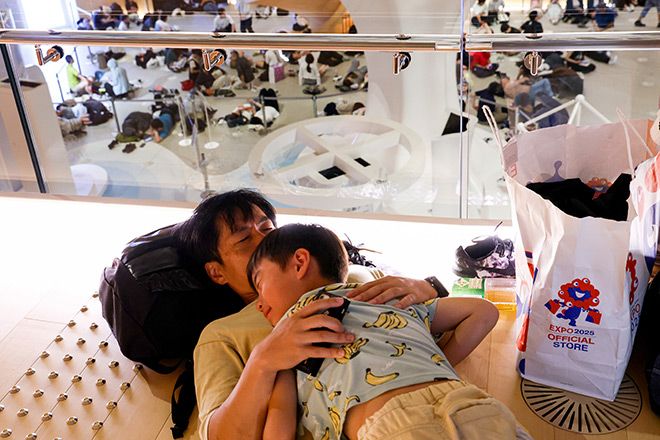OSAKA—Despite anger expressed by stranded visitors, Osaka Kansai Expo organizers gave a generally positive assessment of their on-site response to a service suspension on the sole rail link to the site.
While apologizing for the confusion, the organizers said they could “adapt to the circumstances.”
“At the end of the day, no major accidents occurred,” Jun Takashina, deputy secretary-general of the Japan Association for the 2025 World Exposition, told a news conference on Aug. 14. “I believe that, fundamentally, we were able to handle the situation appropriately.”
Many visitors spent the night at the expo venue after a power outage halted the entire service on Osaka Metro Co.’s Chuo Line on the night of Aug. 13.
Many of those who were unable to return home expressed dissatisfaction with the expo organizers, particularly concerning how information was communicated.
Takashina acknowledged such issues as the timing of information releases.
“When we look at individual details, there are various points to reflect on,” he said. “We intend to thoroughly review them and make improvements.”
Osaka Metro notified the association of the suspension around 9:30 p.m. on Aug. 13, when many expo visitors were heading home, association officials said.
Within 15 minutes, the association restricted departures from the East Gate, which directly connects to Yumeshima Station on the Chuo Line, and urged visitors to remain inside the expo venue.
The organizers said they were concerned about the risk of a crowd crush.
When the Chuo Line was halted, about 30,000 people were in and around the venue.
After 10 p.m., a shuttle service began between Yumeshima Station and the neighboring Cosmo Square Station.
But the association feared a potential safety hazard if people rushed toward Yumeshima Station.
To prevent the risk, the association allowed those already near the station to leave, while continuing to urge others to remain inside the venue.
The organizers initially did not anticipate a prolonged suspension.
It was only around midnight when they switched to what they called a “disaster-level response” after concluding that a full-service resumption was unlikely and that visitors would be stranded.
Expo pavilions were asked to accommodate visitors inside.
But even under the disaster-level response, distribution of bottled water to visitors did not begin until 4 a.m. on Aug. 14, more than six hours after the suspension started.
Some pavilions did not open their doors until 3 a.m., waiting for instructions from the association.
The expo is being held on Yumeshima, a manmade island in Osaka Bay.
The latest incident again highlighted the vulnerability of transportation access to the venue, which had been pointed out before the expo opened in April.
When the Chuo Line was suspended on the night of April 22, about 4,000 people were stranded at Yumeshima Station.
Back then, it took the expo organizers about 20 minutes to grasp the situation, and communications with Osaka Metro were identified as an issue.
This time around, information on the suspension was shared within three minutes.
The expo site also experienced a problem when a powerful earthquake struck near Russia’s Kamchatka Peninsula on July 30. A tsunami advisory was broadcast after the expected arrival time of the waves.
With typhoon season continuing, a review of countermeasures for transportation disruptions and natural disasters remains a priority until the expo closes in October.
(This article was compiled from reports by Kazuhito Suwa, Yoshiko Sato and Yuiichi Nobira.)


AloJapan.com